FL-115 Divorce Form (Proof of Service of Summons)| Guide
Read our blogs to get tips on California uncontested, online, and DIY divorce.
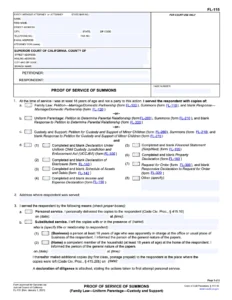

Share

Share
Starting a divorce in California? Filing the FL-115 Proof of Service of Summons correctly is a critical step. This form officially serves as proof that you notified your spouse of the divorce, a legal requirement for the court.
Errors on this form can lead to significant delays. This article will guide you in filling it out yourself in an economical manner. Try The Complete Divorce. It’s the best online California divorce service to help you do your entire divorce without a lawyer and the pains of expensive litigation. Check your divorce eligibility before proceeding!
What is Form FL-115 in California Divorce?
Form FL-115 is the official Proof of Service of Summons for the Petition, FL-100, in California family law cases. It is a sworn declaration that outlines how, when, and where you delivered the initial divorce documents to your spouse (the respondent).
Its purpose is to legally demonstrate the respondent was served, including important documents such as the Petition (FL-100), Summons (FL-110), and a UCCJEA (FL-105) if there are children.
This form is incredibly important, because without it, the court has no proof that your spouse was served.
When FL-115 is Used and Who Needs to Fill and File the FL-115?
You will use this form after your spouse has been served. Either you or the person who serves the papers (a non-party adult or process server) will fill this out.
However, the server will sign it, not the Petitioner. Then, as Petitioner, it is your responsibility to file the completed form with the court to prove service has been accomplished.
How to Fill out FL-115 (Proof of Service) Form?
This form is filled out either by the Petitioner or the server – the adult who delivered the papers. However, if you have your server complete it, make sure it is completed correctly, then file it with the court. Here is how to properly fill out this form.
Filling Out The Initials (Contact and Court Info)
This portion will identify your case for the court. This is how to fill it out accurately:
- Court and County: Enter the full name of the Superior Court, including its branch (e.g., “Superior Court of California, County of Alameda”).
- Case Number: This is your actual assigned California divorce case number. This space must be completed.
- Petitioner and Respondent: Enter your and your spouse full legal names as they appear on your Petition (FL-100).
Attorney or Self-Representation (“In Pro Per”):
- If you are represented by an attorney: Your attorney will fill it out with their State Bar number, name, firm address, and your name after “Attorney for.”
- If you are self-represented: This is the most common situation for a DIY divorce. You have two choices:
- Leave it blank.
- Or, after “Attorney for” write Self-Represented. to indicate that you are representing yourself.
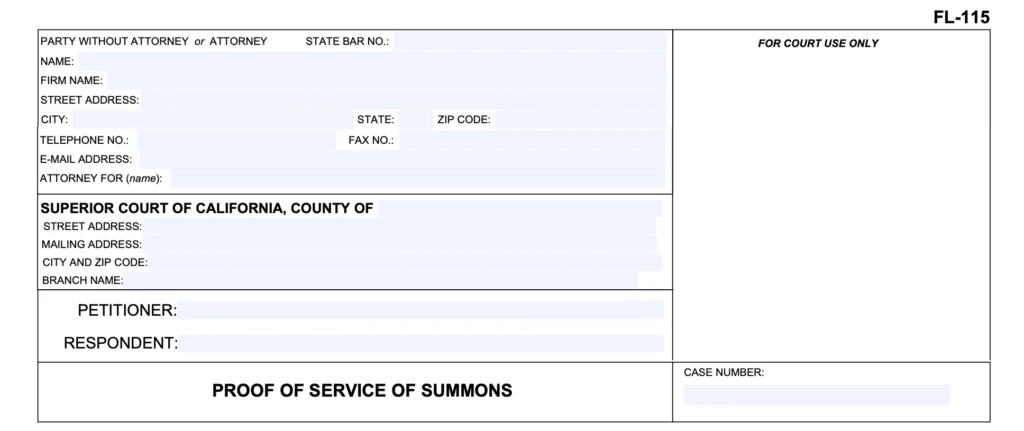
Section 1– Mention Reason for Serving
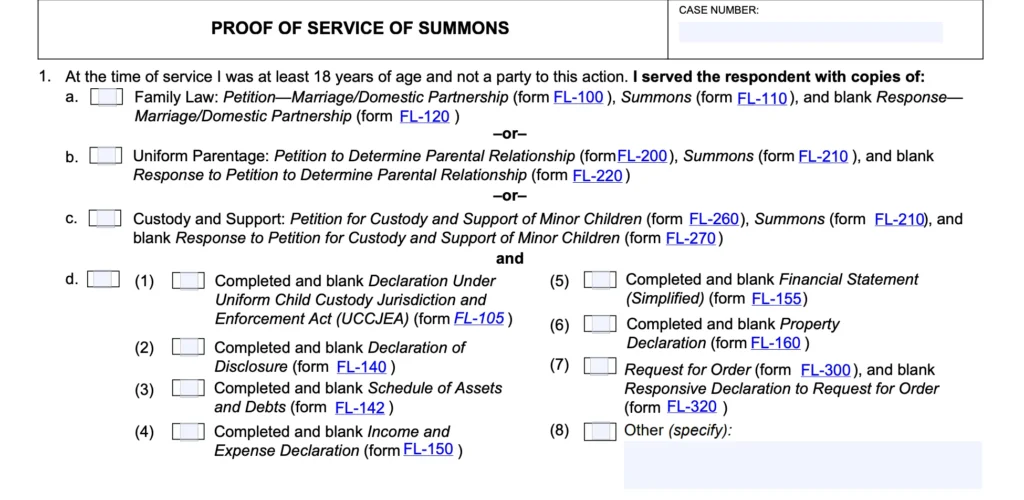
This portion includes the affidavit of the server. They must state: “At the time of service, I was at least 18 years of age and not a party to this action.” Basically, the person who serves the papers cannot be you (the Petitioner) or your minor child.
The server must then check every box that applies to the papers given to the respondent.
(a) Family Law:
This is the most common choice for a divorce. The server must check this box if they served the core documents which are:
- Petition (form FL-100)
- Summons (form FL-110)
Blank Response (form FL-120)
(b) Uniform Parentage:
If you are starting a case to establish parental rights (i.e., unmarried parents), please check this box. This would include serving the following documents:
- Petition to Determine Parental Relationship (form FL-200)
- Summons (form FL-210)
- Blank Response (form FL-220)
(c) Custody and Support:
Check this box if, in addition to the divorce papers, you filed and served papers for custody and support, such as a Petition for Custody and Support (FL-260).
(d) Subsection
This subsection contains any other documents that were served with the Summons and Petition. The server will only check the boxes for the ones they did serve.
- FL-105 (UCCJEA): If there are minor children, this is extremely important. You cannot serve your case without serving the FL-105. So, make sure to check this box.
- Other Financial Forms (FL-140, FL-142, FL-150, etc.): Usually these preliminary financial disclosures are mailed separately after the first service. Only check these boxes if you had instructed your server to physically hand them along with the Summons and Petition.
- Request for Order (FL-300): Only check this box if you opened your case by asking for immediate temporary orders (like spousal support, custody, etc.) and had your motion papers served.
The server needs to look at what they are serving in the packet and only check whatever box or boxes they are serving. For most simple divorces, you would check 1(a) Family Law and the FL-105 box in subsection (d) if you have kids.
Section 2 - Fill out the Address Where Respondent was Served
The server must write the exact physical address (street, city, state, ZIP code) where the respondent was actually delivered the papers. A P.O. Box is not adequate if you did personal service. This accuracy is important to the court record.
Section 3: Mention How You’re Going to Serve
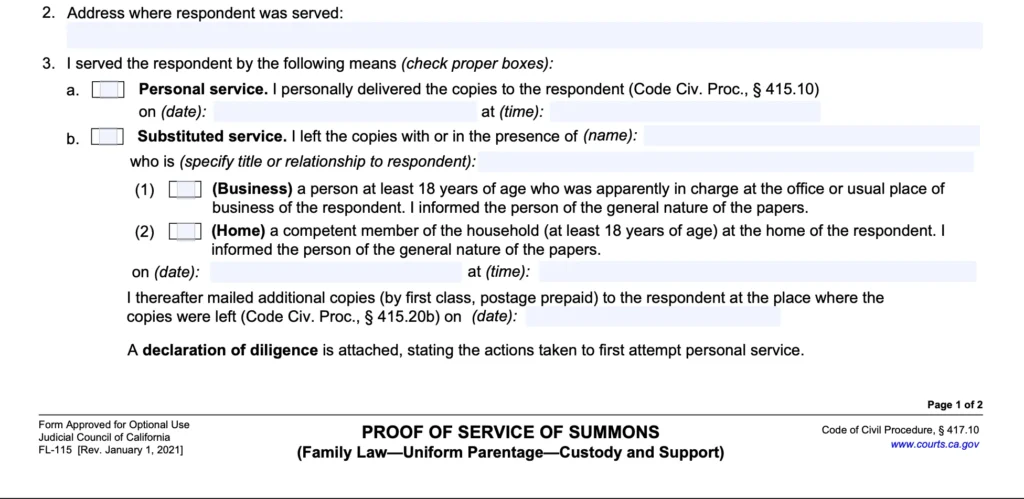
The server is only required to check 1 box to indicate the method of service used: Personal Service, Substituted Service, or Mail (which requires a signed FL-117). Choosing the correct method is critical for the service to be valid, as a matter of law.
Section 4: Person Who Served Papers
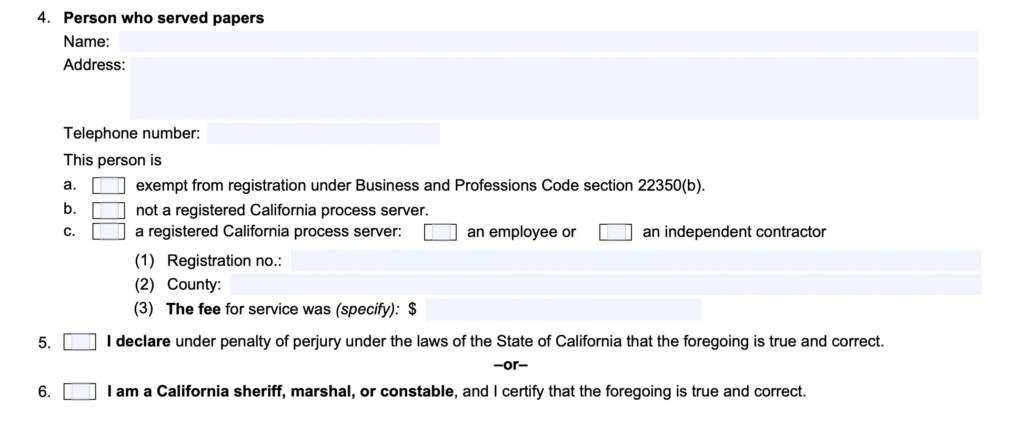
The server must print their full name, provide their street address, and provide a current telephone number. This serves to identify the server to the Court, and to permit verification if necessary.
Sections 5 and 6: Person Who Served Papers
In Section 5, the server must write the precise date and time (with AM/PM) that they served the documents.
Section 6 requires the server’s original signature and the date they filled out this form, certifying that everything on the form was true under penalty of perjury.
The Last Section

Completing the last steps is a matter of precision. Here is a simple checklist to make sure that your Form FL-115 is completed and filed correctly.
Before You Start
- Have all documents for service completed, signed and filed: Your FL-100, FL-110, one blank FL-120, and an FL-105 (if you have children).
- Choose a qualified server: Any adult over 18 who is not a party to your case.
Filling Out the Form
- Section 1: The server needs to mark each box for every document served, including (but not limited to) FL-100, FL-110, FL-120, and FL-105.
- Section 3: The server needs to select the proper method of service. Personal service (hand delivery) is a common method of service. Service by mail will only count if the respondent signs a Notice and Acknowledgment of Receipt (Form FL-117) and returns it.
- Section 4 & 5: The server’s complete contact information and the exact date, time, and address of service.
Tip: Carefully verify that the time (AM/PM), address, and served document list is 100% correct to avoid rejection.
Filing with the Court
- Submit the original signed FL-115 form to the court clerk (in person or by mail), and if by mail remember to include a stamped self-addressed envelope for the clerk to return your file-stamped copy.
- You will want to keep a copy of the filed form for your records as it is proof you have completed this crucial requirement.
How to File Form FL-115?
Completing this form correctly is the last action to officially record that your spouse has been served. Here are a few things to know, and things to avoid.
Who files it & When to file it:
- Who: You, the Petitioner, are the person filing the FL-115 with the court.
- When: File it right away after your server completes service and signs the form. You will have to file this first before you are able to request a default.
Things to Avoid:
- Filing without a signature. The server has to sign.
- Inaccurate information. Check dates, times, and addresses.
- Checkboxes missing. Check that you have listed all served documents in Section 1.
- Using an ineligible server. You must not list yourself as the server or any minor.
The FL-115 Filing Process:
- Confirm Eligibility & Download Forms: Verify that you meet California’s residency requirements to file for divorce. Download the official FL-115 PDF from the court’s website or use an option like The Complete Divorce if you prefer user-friendly forms with no mistakes and help from professionals.
- Fill out the forms: Make sure to fill out the form very carefully using the instructions from above.
- Make Copies: Make at least two copies of your signed, original form.
- File with the Court: Bring your original form and two copies to the clerk’s office at the courthouse where you filed your case. You may need to file in person; you may be able to send it in the mail (make sure to include a self-addressed stamped envelope for them to return it to you).
- Keep Your Records: The clerk will keep your original and return a file-stamped copy to you. Keep that copy together with your other important documents related to your case.
What to do after filing FL-115?
Once you filed the FL-115, the time starts running for your spouse. The Respondent has thirty (30) days from the date of service to file a Response (FL-120).
- If they respond: both parties will move into required disclosures and negotiations.
- If they do NOT respond: After thirty (30) days, you can request a default judgment. This entails filing a few more forms, including the Request to Enter Default (FL-165) and your proposed judgment, to request the court grant the divorce on your terms.
Filling and Filing FL-115 without a Lawyer in California
You can confidently fill out and file the FL-115 alone. The only thing that really matters is accuracy: make sure the server fills it out accurately, lists every document served, and lists the precise date and address of service.
If there are mistakes, you may end up with needless delays and expenses. If you have concerns and want assistance, you could go to a service provider like The Complete Divorce to help make sure it is done properly.
The Complete Tips For FL-115
You will have to be accurate when you are going through the divorce process. Completing the FL-115 properly is important to avoid delays in your case so that your case can progress.
1. Ensure Proper Documentation
All information on the FL-115 must be correct. This means the court’s information, your case number, the server’s contact information, and the complete list of every document served (FL-100, FL-110, FL-120, FL-105 if you have children).
The number one reason courts reject this form is for incorrect or missing information. This could delay your case entirely. If you want to rest easy, try a service that offers an expert review.
At The Complete Divorce has a complete package we’ve easy to follow forms automation and MSA builder, simple video instructions, and, importantly, full review of all your paperwork packet by a Divorce expert before you file it with the court. So you can be 100% sure the paper work is correct and flawless, and feel like you had an attorney review it, without the cost.
2. Ensure Proper Service
The requirements for service are exacting. Your server must be a nonparty adult. Don’t ever try to serve via email or social media as those forms will not count for initial papers and the court will not recognize either.
Provide your server with all documents and straightforward instructions about how to serve them—personal service, substituted service, or service by mail and filing an FL-117.
3. File FL-115 Promptly
File the Proof of Service, Fl-115, timely. It is best to file it with the court clerk as soon as you have completed it. Don’t wait. Make sure you keep the file-stamped copy you receive back as part of your official proof that this step was successfully completed.
4. Choose the Best Divorce Service
To maximize your chances of success, use a fully guided DIY program. The Complete Divorce is California’s top solution and provides support for everything from start to finish:
- User-friendly Forms: Forms copy and editable for everything you need including FL-115 and FL-117.
- Professional Review: The completed documents get reviewed for accuracy.
- Filing Support: Clear instructions for how and where to file your documents.
- Customer Support: Customer support and educational resources for the duration of your case.
Service Methods in California: From Ensuring Proper Service to Serving Spouses Outside California
Generally, you can choose from personal service, substituted service, or mail service. However, improper service is one of the most frequent and costly errors. If you serve the divorce papers improperly, the court will deny that your spouse received service, which voids everything and delays your separation and divorce.
*Note: The date of service is also important since the date of service triggers the mandatory six-month waiting period before your divorce can be finalized.
1. Service for Spouses Outside California
It is possible, according to the law, to serve a spouse that does not live in California, but it can be difficult. The main difficulty is jurisdiction; if the spouse does not have substantial contact with California, then the court does not have the power to make a binding order on any property or support.
To help clarify and possibly simplify, it is better if the spouse files a Response (FL-120). Once a spouse completes a Response (FL-120), they have consented to jurisdiction and should ideally be given an uncontested judgment. The server (who can still be a resident of California) would generally just complete the FL-115 with the address and phone number.
2. Types of Services for the Petition for Dissolution of Marriage or Legal Separation
(1). Personal Service
The server hands the documents to the respondent in person. This is the best way to do it. Anyone over 18 years old, and not a party to the action, can do service and your service will be valid.
(2). Mail Service with FL-117
The server mails the papers with a Form FL-117. The mail service method is only valid if the respondent signs and returns that form. With their cooperation, the method works.
(3). Substituted Service
If a responder is avoiding service, the server can leave the papers with an adult that is capable (at their home or workplace) and mail the papers again, this is a last resort.
Conclusion
Accurately completing your FL-115 is critical to complying with the law and moving your divorce case forward. Review each item on your forms for correctness, and consider seeking guided support to help you stay organized.
To put your best foot forward, download the official FL-115 form and check your eligibility for a simple, DIY online divorce in California.
FAQ
Q1. How do you prove service for divorce papers in California?
You prove that you served the Petition for Dissolution of Marriage (FL-100) in California by having your server complete and sign Form FL-115 (Proof of Service of Summons) under penalty of perjury. You then file this original signed form with the court, which is your official record of service. Depending on your county, you can file electronically, by mail, or going to the court.
Q2. Who can serve proof of service in California?
Any person who is at least 18 years old and not a party to the divorce case can serve the divorce papers. This can be a friend, relative, or a professional process server. The same person will then complete the FL-115.
Q3. Do I need to notarize proof of service?
In California, you do not need to notarize the proof of service. The server will sign the FL-115 under “penalty of perjury” which is a statement under the law that has the same effect as a notarized statement.
Q4. What is a FL 105 form for?
Form FL-105 is the Declaration Under Uniform Child Custody Jurisdiction Act (UCCJEA). If you have minor children, the court requires the UCCJEA form to provide information to the court about the children’s home state in relation to the custody jurisdiction. This form confirms that California has the authority or power to make custody orders for the children in your divorce, legal separation or paternity case.
Q5. Who fills out FL-115?
The server (the person that served the papers) fills out and signs the FL-115. The Petitioner can also assist the server by filing out the FL-115. Additionally, as the petitioner, you will have to file the server’s form with the court.
Reviewed By:

I’m Dina Haddad, a family law attorney-mediator in California. I’m so tired of couples not having a process that’s easy to complete their divorce. They are getting lost, wasting time and money, and beyond frustrated with their results.That’s why I created TheCompleteDivorce. I took my successful mediation practice and condensed it into an affordable and winning program.
Q6. What happens if you cannot serve the divorce papers on your spouse?
If your spouse is intentionally evading service, then you may need to resort to “substituted service” (leaving it with another adult and mailing copies) or apply for a court order on an alternative method of service, such as service by publication.
Q7. Can I serve the papers myself?
A party to the case cannot serve papers. California does not allow a party to serve their own divorce papers (you need to use a neutral third party who is over 18).
Q8. What if my spouse doesn’t sign FL-117?
If your spouse does not sign and return the Notice and Acknowledgment of Receipt (FL-117), then service by mail is not valid. You must then serve your spouse using an alternative method, such as personal or substituted service.
Q9. How long do I have to file FL-115?
You must file it as soon as you are served, but you technically have until you ask for a default judgment. There is no definitive time frame, although you might stall your case by taking a long time.
Q10. What happens if FL-115 is filed incorrectly?
The court clerk may reject the form. If it is accepted but mistakes are found later, a judge could void the service, and you would have to re-serve your spouse and start all over again, wasting essential time. You can also amend your FL-115 if you found mistakes and want to rectify the issues immediately.
Q11. Can respondents use FL-115?
The FL-115 cannot be used for the Respondent. The Respondent uses different forms to show that they served documents on the Petitioner. On most responses, they would use either the Form FL-335 (Proof of Service by Mail) or Form FL-330 (Proof of Service by Personal Service) for their Response (FL-120) or other filings.
